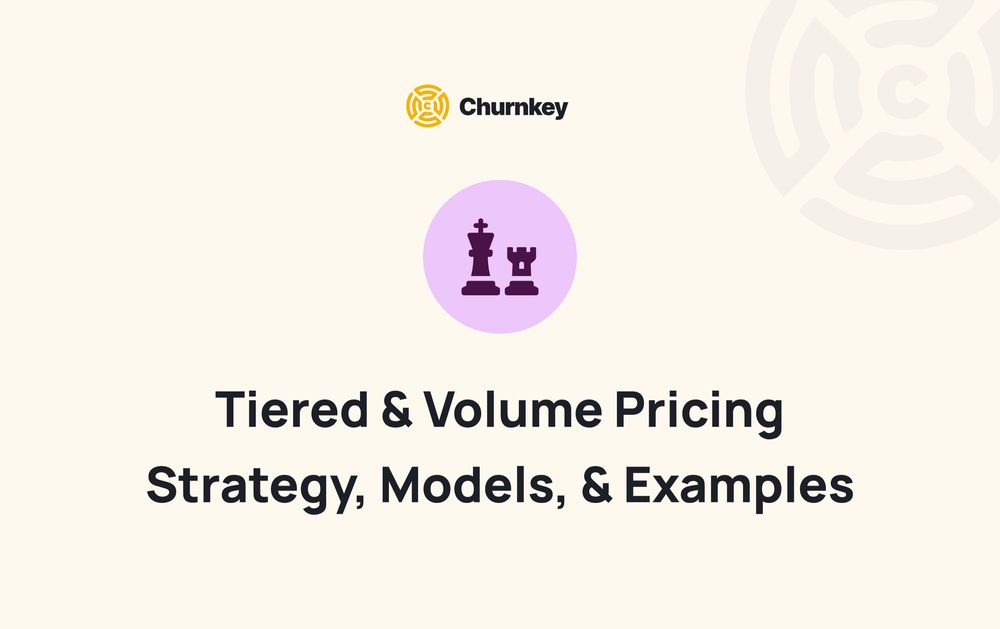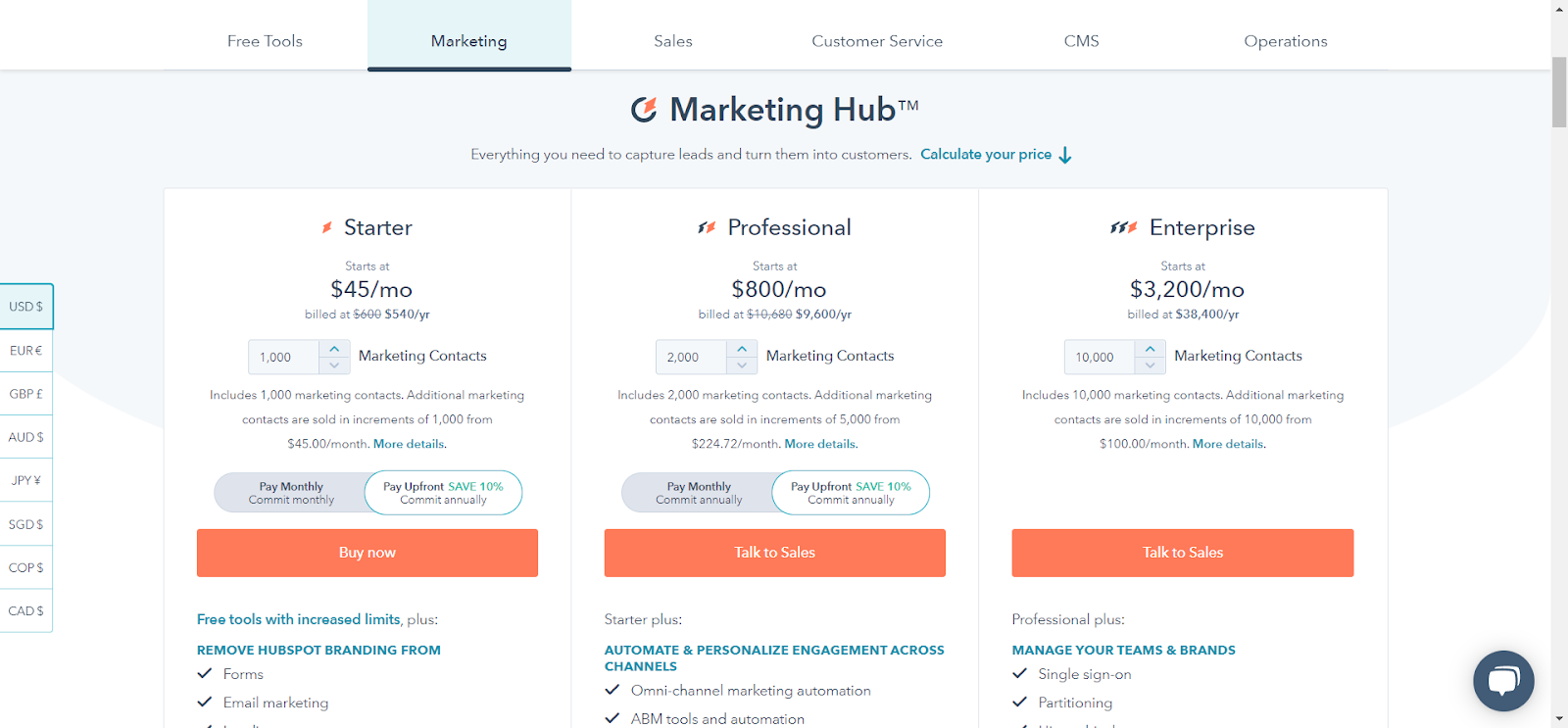Tiered & Volume Pricing Strategy, Models, & Examples
Tiered or volume pricing models can make the difference between a profitable, growing business or a business losing money.

Are you stuck between a tiered vs. volume pricing model for your SaaS business?
When selling software, SaaS, or services online, you could opt for wildly different pricing strategies. Depending on your goals, the tiered or volume pricing model can make the difference between a profitable, growing business or a business losing money with each sale.
Think of it like this: when choosing a pricing model, you want to enrich your customers’ lives, maximize the customer lifetime value and reduce future churn rates. In addition, you want to ensure that you don’t overwhelm or confuse your customers—instead, you want to guide them to the right option for their needs. At Churnkey, we provide detailed reports on your churn rates that could help you find gaps in your pricing strategy.
In this guide, you’ll learn:
- Tiered Pricing Models: Definition, Benefits & Drawbacks
- Volume Pricing Models: Definition, Benefits & Drawbacks
- Tiered Pricing vs. Volume Pricing: Which One Is Best for You
Tiered Pricing Model: Definition, Benefits & Drawbacks
Definition
Let’s start with the definition of tiered pricing. A tiered pricing strategy is based on service tiers, which are packages that offer specific services and features. Users can start with a basic tier and level their way up to more advanced tiers where prices escalate as more features are added.
This pricing model encourages customers to establish a long-term preference for a SaaS company based on monthly or yearly subscriptions. Additionally, tiered discount structures are often applied to long-term plans as they create a win-win situation for both the SaaS business and the customer.
Each tier is determined by the target audience it addresses. A tiered pricing strategy example is HubSpot which offers 3 different tiers: Starter, Professional, and Enterprise. Under each tier are listed the features potential customers get and the value for money. The most usual tiered pricing package names are “Basic”, “Standard,” and “Premium”. Basic and Standard plans have fewer or limited services, while more expensive plans like Premium unlock more features, capacity, and usage.

Similarly, SaaS businesses like Grammarly offer two versions of their software, one free and one paid. This two-tiered pricing example usually unlocks more features in the paid Premium version, like advanced corrections or plagiarism checker. Naturally, there is a third advanced Business plan completing the two-tier pricing model for teams who want to collaborate on the platform.

Tiered Pricing Benefits
Let’s take a look at the benefits of tiered pricing:
- Flexibility & Scalability. Users can upgrade their tier pricing structure at any point when their needs increase. This creates room for upsells, allowing SaaS businesses to roll out advanced features for exclusive audiences.
- Affordability. A tiered pricing method of Basic or Standard packages can be more attractive to price-oriented customers who find the advanced plans too pricey. Furthermore, your SaaS business doesn’t have to self-characterize as a “discount” or “premium” service provider. On the contrary, it can offer packages that appeal to different budgets and are tailored to customers’ needs.
- Brand Trust. Customers who don’t wish to break the bank for unfamiliar software can opt for more affordable tiers and get to know the real value a SaaS business adds. This creates a natural progression to more expensive services as well as word of mouth that brings in new subscribers.
- The customers’ choice. With price tiering, the responsibility of choosing the right software shifts to the customer. This means that they’re able to choose from tailored packages the one that best suits their needs.
- Less commitment. Tiered pricing lowers the bar of commitment for customers, as it provides them a solution to try. In addition, letting them test the product and know its high quality will skyrocket upsells.
- Universally understood. Last but not least, pricing tiers are a universal model that most service providers and users are familiar with. Users will most likely assume that you offer tiered pricing templates before they even land on your website. Therefore, the clearer your prices are displayed in each package, the more likely you’ll be turning leads into customers.
Drawbacks
What are the drawbacks of the tiered pricing model? Let’s examine some pitfalls:
- Vagueness. Customers are not always aware of what they’re buying, and they might not know what the different tier features are. This means that your leads will have to do some homework by watching videos or reading relevant blog posts to figure things out. Let’s hope that lag-time won’t lead them to competitors.
- Wrong tiers. Having the freedom to choose could also mean that customers might make the wrong choice. They might over/underestimate a tier and misunderstand the purpose of your service. For example, they might be thinking that the “Starter” tier is the right one for them—when all along when they should be opting for the “Startup” tier. This can create a negative impact on their satisfaction and lead to high churn rates that’ll affect your company’s valuation. That’s where a product like Churnkey is essential: to prevent users from canceling their subscriptions by offering pricing tiers tailored to their needs.
- Wrong pricing. Piggybacking on our argument above, pricing each tier can be challenging. Manufacturers need to be able to differentiate one tier from the other, decide where to draw the line on the features and how much to charge. One wrong decision could be giving away value and leaving money on the table.
Volume Pricing Model: Definition, Benefits & Drawbacks
Definition
We’ve all been to the movies and stood in line to get popcorn. Once you get to the snack bar, you see that the smallest size costs $3. Then you see that the medium costs a few more dollars, while the large is $7 with unlimited refills. The “large” one seems like a steal, right? So, you end up purchasing a large popcorn, even though you set out to eat a small snack. That’s pretty much what volume pricing is.

Source: behavioraldevlab
A volume pricing strategy focuses on discounts for quantity purchases. The more you purchase, the larger the discount. In other words, you’re selling your products or services in bulk.
A volume pricing example is Shutterstock which uses volume-based pricing for their stock images as downloadable digital products. Users can opt for bundle packages depending on the number of images they want to download.

Benefits
Now that definitions are out, let’s look into the benefits of a volume pricing strategy:
- Simplicity. Volume-based pricing is pretty straightforward for both service providers and customers. Manufacturers provide the whole experience of their products or services, and they just decide on the discount. At the same time, customers are able to pay according to their desired quantity and get the most out of their product or service.
- Quantity orders. Bulk offers encourage larger orders. Manufacturers are willing to receive lower per-unit prices focusing on quantity sales. As a result, customers are prompted to make larger purchases to earn the attached discount, which increases the SaaS business’s profits.
- Freeing time from the sales department. Unlike tier pricing models that often require more touchpoints between customers and sales, volume prices are pretty straightforward to understand and make everything move faster.
Drawbacks
Naturally, the volume pricing model is not all butterflies and rainbows. Here are some downfalls you should be considering:
- Lowering price value. If your business constantly uses the volume prices, it will automatically be perceived as a “discount” brand and the new standard for consumers. As a result, if you attempt to raise your prices in the future, not only you’ll lose most of your customers, but it’ll also seem controversial to your identity.
- Loss of profit. By offering frequent discounts to users, you lose a big part of the profit pie, which will affect your business revenue in the long run.
- Lack of reliability. A business that constantly resorts to discounts to sell might give the impression that it has low-quality products or is not trusted by consumers. To avoid that, you must establish a central pricing authority. For example, acquire new customers with volume prices and retain them at regular prices.
Tiered Pricing Vs. Volume Pricing: Which One Is Best for You?
So now you know what tiered and volume pricing is and their pros and cons. However, one question still needs to be answered: which one is ideal for you?
Frankly, it depends on your business. Most SaaS businesses opt for the tiered pricing method to target different audiences and offer additional benefits to advanced users. So, if your goal is to attract new users to test your product and let them decide what suits their needs, this might be the suitable pricing model for you.
If, however, your goal is quantity purchases, such as commodities or digital products, the volume pricing strategy is probably the right fit. As long as you go easy on discounts and protect future pricing increases, this strategy will make sense for your business.
Before we go, just remember that whatever pricing model you choose, it all comes down to analyzing your SaaS churn to decide if your strategy is working or not. Start with Churnkey’s free trial today and take your business to the next level!



